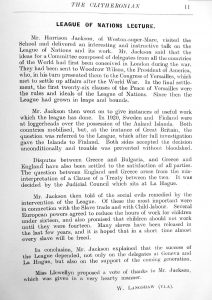
Article on League of Nations Union lecture, The Clitheronian, 4 (4), 1930
Courtesy of Clitheroe Royal Grammar School
Clitheroe Boys’ Grammar School was founded in 1554. It amalgamated with Clitheroe Girls’ Grammar School in 1985. (1) In the mid 1920s, a pupil, N. Fish, promoted Esperanto. In 1925 he had won a prize in the Lancashire and Cheshire examination, which enabled him to attend the Edinburgh Esperanto Conference. He set up a society at school, advocating that a universal language was needed to stop misunderstandings in translation that might lead to war. The society had failed by 1931, but was revived in 1932 when an Esperanto class was formed, following a visit from Mr Montague Butler, Secretary of the British Esperanto Society. Mr Butler demonstrated a model lesson using the direct method and an Esperanto singing lesson. About ten pupils attended the class, aided by Mr Coles. However, there is no further mention of Esperanto.
The School had an active Junior Branch of the League of Nations Union (LNU). Annual lectures on the League of Nations , sometimes held jointly with the Girls’ Grammar School, included Mr Harison Jackson in 1931 and Mr Bailey, a school governor and Chairman of the Clitheroe LNU branch in 1932. Mr Bailey’s son, Gerald, Secretary of the National Peace Council, spoke to the school in 1933. He returned in 1938 to talk to both schools on ‘Armed Truce or Lasting Peace,’ maintaining that the League of Nations was the best organisation to maintain peace. A ‘mock Council meeting’ was held on Manchuria in 1932. Boys also sometimes attended local LNU branch meetings. (2)
References/Further Reading:
(1) Clitheroe Royal Grammar School. About us: History and Foundation.
(2) The Clitheronian, 1925 -1939. Clitheroe Royal Grammar School Archives.
D. Newnham, 2003. A Beginner’s Guide to Esperanto. Guardian.

